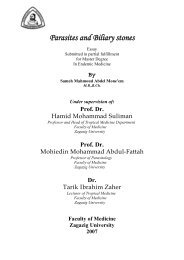Study of respiratory symptoms among sputum positive
Study of respiratory symptoms among sputum positive
Study of respiratory symptoms among sputum positive
Create successful ePaper yourself
Turn your PDF publications into a flip-book with our unique Google optimized e-Paper software.
LJ I<br />
!((rWW0/Literature<br />
Immune mechanisms<br />
A) Cell-mediated immunity (Acquired cellular resistance) :<br />
Cell- mediated immunity (CMI) can be defined as a beneficial host<br />
response characterized by an expanded population <strong>of</strong> specific T.<br />
lymphocytes. That, in the presence <strong>of</strong> microbial antigens, produce<br />
cytokines locally. These cytokines attract monocytes/macrophages from the<br />
blood stream into the lesion and activate them, interferon-v (IFN- y) and<br />
tumor necrosis factor-a (TNF-a) are major macrophage-activating<br />
cytokines (Belosevic et al., 1988 and Celada & Nathan, 1994). INF-yalso<br />
induces interleukin 2 (IL-2) receptors in monocyte macrophages, after<br />
which IL-2 becomes an additional activating cytokine for these phagocytes<br />
(Holter et aI., 1987). Activated macrophages produce reactive oxygen<br />
(Kleban<strong>of</strong>f, 1988) and nitrogen intermediates (Liew and Cox, 1991),<br />
lysosomal enzymes, and other factors that kill and digest tubercle bacilli<br />
(Remick and Friedland, 1997). Acquired cellular resistance (ACR) is<br />
characterized by the presence <strong>of</strong> a local population <strong>of</strong> activated<br />
(microbicidal) macrophages, produced by eMI (Dannenberg, 1989) (i.e<br />
By the cytokines <strong>of</strong>antigen-stimulated lymphocytes) (Barnes et al., 1990).<br />
In the 1960, Machaness showed that acquired cellular resistance<br />
once produced, was non specific. Activated macrophages could destroy or<br />
inhibit many types <strong>of</strong> facultative intracellular bacteria, not just the type that<br />
caused their activation. However, once these activated macrophages have<br />
disappeared, following the healing <strong>of</strong> the primary infection, only the<br />
specific bacterial species could rapidly produce them a gain. This rapid<br />
"recall" response is due to the presence <strong>of</strong>expanded populations <strong>of</strong>long<br />
lived (i.e. non dividing) recirculating Th. lymphocytes (memory cells) with<br />
19
















